Designing Fastened Parts for Automation: What You Need to Know
There are many considerations when dealing with parts to be assembled. One overriding goal, however, should be to automate as much of the process as possible. Here are six things to consider that may help eliminate costly errors and design challenges.
What makes for a good part?
What does a good part look like? From a fastening point of view, a good part incorporates locating features to easily align the two pieces. Take a lid and the body of a device, for example. When attaching the lid, it is helpful when there is a lip that the lid slides and secures onto as screws are driven to seal the two pieces together during assembly.
When complicated part geometry exists, vertical pins or tapered pins with through-holes in the cover should match up with holes in the base so that tapered pins line up and go exactly where they should.
In other cases, adding sufficient holes so that parts are not easily misaligned or flipped around works well. Ensuring that the operator cannot mistakenly rotate a part requires planning so that parts only fit together when in the correct orientation.
The mating of components using these methods ensures that fasteners are only used to secure the assembly rather than drawing parts into alignment.
Ultimately, a good part is one where a physical obstruction does not block access to a screw installation. Even extremely qualified and high-profile companies often produce designs that block a screw hole. In that case, an operator must manually push the screw in and the screw often comes out at an angle. There’s no way to effectively automate this situation because it requires operator manipulation to get the screw to drive.
What are the typical pain points often experienced?
Pain points ineffective design for automation involve quality, surface marring, time, repeatability and ergonomics.
A quality hit is typically the first clue that an issue exists. When something doesn’t line up, or an operator has to align pieces or insert screws by hand, chances are great that part rejections will follow. In addition to alignment, the marring of the part is common. When operators intervene and install a screw, it’s easy to scratch or drag metal across the exterior of the part that is visible to the customer. In these cases, there will be reworked or the item is completely scrapped as unsuitable for retail.
When it takes excessive time and effort to align parts, delays plague a high-volume application. Once operators are involved, they may solve the challenges at hand, but over time their involvement will negatively affect repeatability.
There are also ergonomic issues for operators, causing manufacturers to incur costs associated with operator injuries because of the contortions required to get the screw in the hole. Carpal tunnel problems and tendon surgeries are not uncommon.
What are typical challenges when launching a new product or bringing up a new line?
There is always a learning curve when launching a new product and bringing up a line. Manufacturers gradually discover more about their new parts. Visumatic often hears statements like, “Oh, I didn’t know this material would flex this way,” when the screw locations on a cover are off. Sometimes when one screw is tightened down, a screw in the opposite corner suddenly pops up, bends sideways or can’t be driven in without extra manipulation. Knowing the attributes of the materials involved as well as their strength and behavior goes a long way to avoiding this type of situation.
Mating part alignment is a twofold and major challenge. Locating features can make it simple to join two pieces together. If designed properly, a part goes where it is supposed to, lining up in the process so that a machine can reliably load the part. Prior to installing a fastener, there are two holes that must line up -- one in the cover and one in the base. However, if a cover slides on in a certain way and causes a shift in the alignment, one of the holes is completely covered. A human can often intervene and troubleshoot, but a machine can’t do that.
Product design often ignores the level of operator involvement needed to manipulate parts for assembly. Awareness, unfortunately, tends to occur only after expensive automation deployment. Unfortunately, some parts require so much manipulation the design cannot be automated. In this case, it’s back to the design drawing board.
How to avoid common mistakes
There are two different levels of automation. With the first level, an operator is involved, such as a human with a screwdriver and a screw. The operator manually positions the screw and drives it in. To automate that process requires an automatic feed-and-drive gun that an operator will hold. The operator, in this case, pushes the screw into the hole and drives it in, repeating the process a number of times. Operators require something to physically touch or locate against to know that they are in the correct spot.
With the second level of automation, there is no operator. The machine, position of the tooling and the driving of all of the screws are all automated. In this case, locating features are designed into the part that allows the interface between the automation tooling and the part itself.
Another pain point is driving into a counterbore. Design features can be added to the counterbore that allows the operator to locate and drive efficiently with it. If these features aren’t present, however, it is nearly impossible to make the process work. There needs to be a lead-in at the part surface, for example, for the tooling to rest on to locate that lead-in. There is also a larger diameter at the top before it decreases to the normal diameter for the clearance around the screw head. Features at the bottom of the hole where the hole is tapered include the elimination of sharp corners, which creates curved sides so that the screw always travels towards the center of the hole. There, it efficiently hits the part it threads into.
What constitutes a really bad part?
One part that fell into the “really bad” category was an automotive HVAC motor assembly. The plastic design featured small, hard and flat mounting locations that could be bolted into the vehicle. The automotive manufacturer placed a large mounting area right over the screw-drive hole. While it might have been physically possible for a human to manipulate that, it was impossible for the machine to put tooling in because of the limited vertical clearance.
In this case, the customer had to move that screw drive location and add an operator to the assembly process to install a single screw. If, when they designed the part, they had left an inch to the right and left of the screw location, all would have been fine. However, it was hidden underneath the corner of a bracket and unfortunately, the project was so far along that there was no going back. It cost at least an extra $20,000 or more per year to make the product for the oversight.
How can I get help?
Knowledge is what you get five seconds after you need it. Visumatic’s goal is to deliver it sooner, creating a partnership with customers and alleviating challenges early on. For example, business development engineers work closely with customers to review their part design and process, then Visumatic recommends any necessary changes in design, process or fastener type. Early review means there is time and flexibility to make changes before ramping up to full production. Otherwise, it’s very costly and emotionally draining once problems are firmly set in stone.
Visumatic can provide tooling CAD that can be dropped into the product design model to verify clearances and access, contributing to the overall success of the product long before launch.










